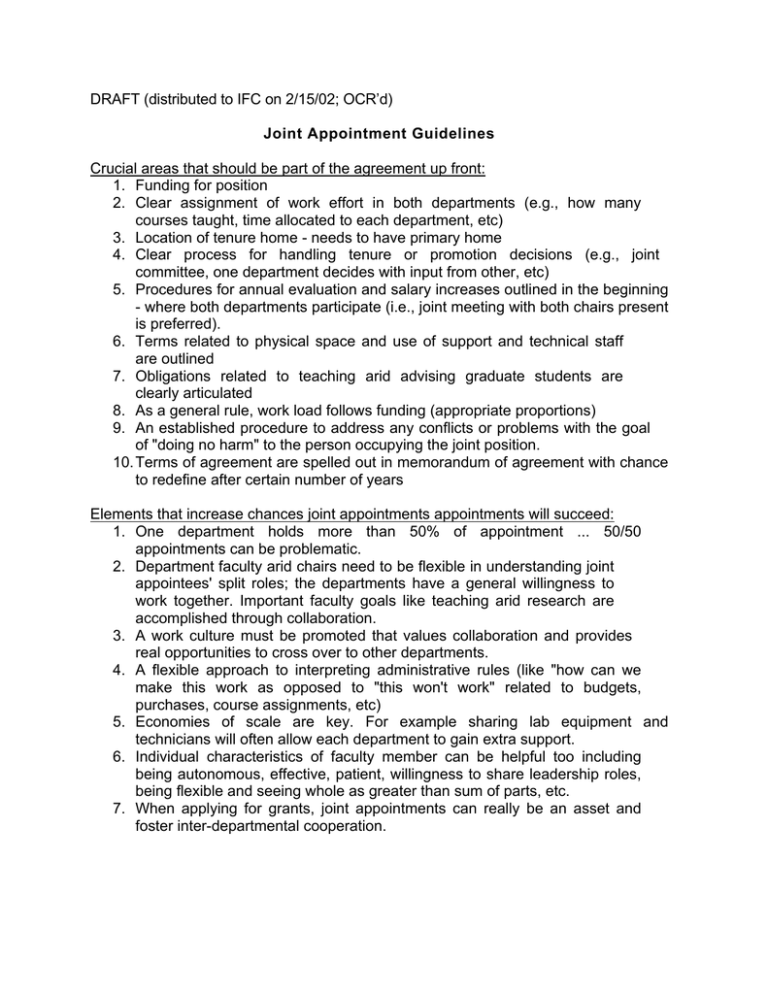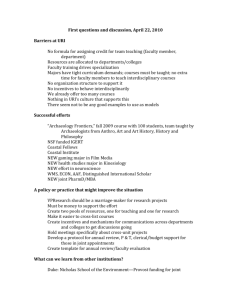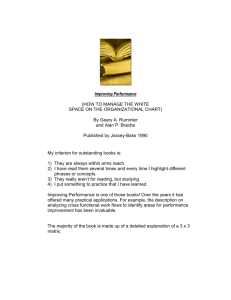DRAFT (distributed to IFC on 2/15/02; OCR’d) Joint Appointment Guidelines
advertisement

DRAFT (distributed to IFC on 2/15/02; OCR’d) Joint Appointment Guidelines Crucial areas that should be part of the agreement up front: 1. Funding for position 2. Clear assignment of work effort in both departments (e.g., how many courses taught, time allocated to each department, etc) 3. Location of tenure home - needs to have primary home 4. Clear process for handling tenure or promotion decisions (e.g., joint committee, one department decides with input from other, etc) 5. Procedures for annual evaluation and salary increases outlined in the beginning - where both departments participate (i.e., joint meeting with both chairs present is preferred). 6. Terms related to physical space and use of support and technical staff are outlined 7. Obligations related to teaching arid advising graduate students are clearly articulated 8. As a general rule, work load follows funding (appropriate proportions) 9. An established procedure to address any conflicts or problems with the goal of "doing no harm" to the person occupying the joint position. 10. Terms of agreement are spelled out in memorandum of agreement with chance to redefine after certain number of years Elements that increase chances joint appointments appointments will succeed: 1. One department holds more than 50% of appointment ... 50/50 appointments can be problematic. 2. Department faculty arid chairs need to be flexible in understanding joint appointees' split roles; the departments have a general willingness to work together. Important faculty goals like teaching arid research are accomplished through collaboration. 3. A work culture must be promoted that values collaboration and provides real opportunities to cross over to other departments. 4. A flexible approach to interpreting administrative rules (like "how can we make this work as opposed to "this won't work" related to budgets, purchases, course assignments, etc) 5. Economies of scale are key. For example sharing lab equipment and technicians will often allow each department to gain extra support. 6. Individual characteristics of faculty member can be helpful too including being autonomous, effective, patient, willingness to share leadership roles, being flexible and seeing whole as greater than sum of parts, etc. 7. When applying for grants, joint appointments can really be an asset and foster inter-departmental cooperation. Where problems can occur: 1. Departments that are used to thinking in traditional academic discipline lines. Departments that already draw from various fields are often more comfortable with joint appointments (i.e., schools of public health, medicine, professional schools, etc.) 2. One or both departments are inflexible in regard to the journals and where their faculty members publish (i.e., insist on traditional outlets as the only places to publish). 3. Departments who see themselves as separate units make it much harder (i.e., more of a silo effect). If a department has not had experience with joint appointments it may not be used to thinking collaboration. 4. Two full departmental reviews for promotion and tenure. It is probably best to a have primary department with joint group or committee that meets to review final department recommendations. 5. Geographical distance can be a problem. Often is useful to have a presence in both departments to foster connections. 6. When chairs or faculty members insist that the joint appointee attend all meetings in both departments. 7. Where chairs are not flexible and willing to give and take ... and to get advantages. In summary, joint appoitments are often related to the ability to manage the different relationships and resources.






